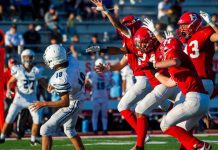The man with the Midas touch
He was the first guy to script the first 15 plays. He was the
first to laminate the play card.
He was the first guy who understood the importance of using the
pass to set up the run, instead of the traditional way, which was
the other way around.
The man with the Midas touch
He was the first guy to script the first 15 plays. He was the first to laminate the play card.
He was the first guy who understood the importance of using the pass to set up the run, instead of the traditional way, which was the other way around.
He was called “The Genius” long before he was elected into the Pro Football Hall of Fame in 1993. His name is synonymous with the San Francisco 49er teams of the 1980s just as much as it is for being the architect of the West Coast Offense.
Today, it’s hard to find a single coach in the NFL who hasn’t run or thought about running his style of offense, and it’s almost equally as hard to find one who, in one way or another, wasn’t a disciple of his teachings. Yes, Bill Walsh left a huge impact on the National Football League.
On Monday morning I learned Walsh, the head coach of the 49ers during the teams storied years in the 1980s, had died of leukemia at the age of 75. I couldn’t help but think about what the man meant to the 49ers organization and pro football in general.
Without Walsh, the 49ers would probably still be looking for its first Super Bowl ring, not its sixth. Without Walsh, there might not be an NFL Europe, which he helped establish in 1994 under the heading World League of American Football.
Without Walsh, guys such as George Seifert, Mike Holmgren, Dennis Green, Sam Wyche, Ray Rhodes, Bruce Costlet – all of whom served on Walsh’s 49ers staffs – might not have made it into the NFL.
Take those names and toss in the fact that Tony Dungy played for him, and that most of his former assistants took what they learned from Walsh and passed it down to their staff members and you’ve got the who’s who of the NFL.
Some of those names include: Mike Shanahan, Jon Gruden, Brian Billick, Andy Reid, Pete Carroll, Gary Kubiak, Steve Mariucci and Jeff Fisher.
Yes, guys like Montana, Craig, Lott and Rice might get all the credit for making the plays on the field, but it was Walsh who could spot the talent on draft day. It was Walsh who took that fresh talent and knew just how to season it with veteran free-agent
players at the optimum time without jeopardizing team chemistry or the annual goal of winning the Super Bowl.
Walsh was the guy who drafted Rice, Montana, Lott, Hicks, and the same guy who brought in Charles Haley and Steve Young. He was also the guy that wanted to bring in Jake Plummer.
He became the team’s general manager in 1982 and its president in 1985. In January 1989, after winning his third Super Bowl, he handed the coaching reigns over to Seifert, who followed suit by guiding the 49ers to another Super Bowl title the next season.
In 1999, after a three-year stint with NBC as a commentator and a return trip to the Stanford Athletic Department, Walsh was called in to clean up the front office and help to regain the team’s winning ways. One of his first moves was to bring in Gilroy native Jeff Garcia, who took over the team’s quarterbacking duties after Steve Young retired, and went on to be a three-time Pro Bowler in the league.
Yes, it is clear that everything Bill Walsh touched seemed to turn to gold, and those of us that follow the red and gold will never forget it.









